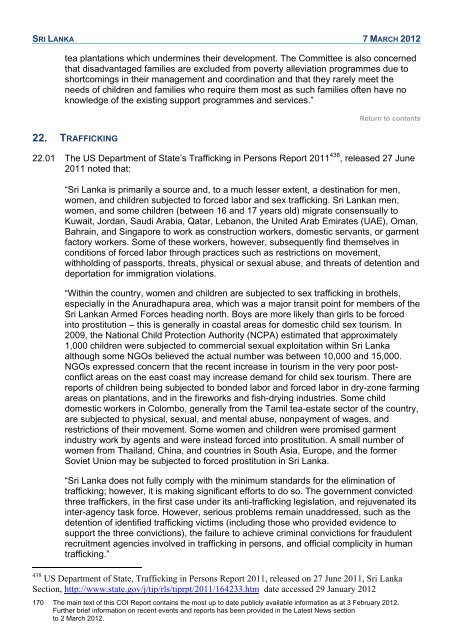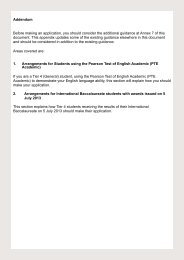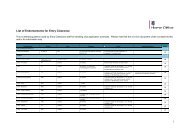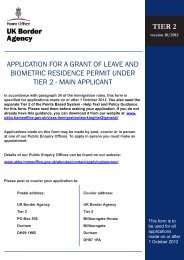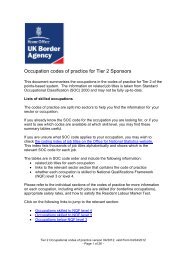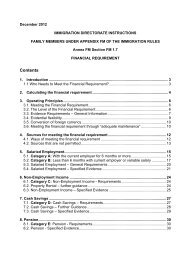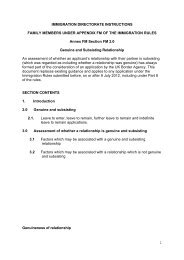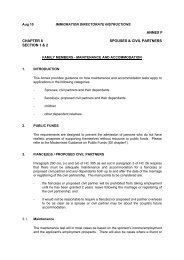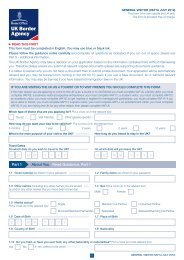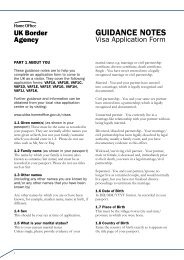COI Report March 2012 - UK Border Agency - Home Office
COI Report March 2012 - UK Border Agency - Home Office
COI Report March 2012 - UK Border Agency - Home Office
You also want an ePaper? Increase the reach of your titles
YUMPU automatically turns print PDFs into web optimized ePapers that Google loves.
SRI LANKA 7 MARCH <strong>2012</strong><br />
tea plantations which undermines their development. The Committee is also concerned<br />
that disadvantaged families are excluded from poverty alleviation programmes due to<br />
shortcomings in their management and coordination and that they rarely meet the<br />
needs of children and families who require them most as such families often have no<br />
knowledge of the existing support programmes and services.‖<br />
22. TRAFFICKING<br />
Return to contents<br />
22.01 The US Department of State‘s Trafficking in Persons <strong>Report</strong> 2011 438 , released 27 June<br />
2011 noted that:<br />
―Sri Lanka is primarily a source and, to a much lesser extent, a destination for men,<br />
women, and children subjected to forced labor and sex trafficking. Sri Lankan men,<br />
women, and some children (between 16 and 17 years old) migrate consensually to<br />
Kuwait, Jordan, Saudi Arabia, Qatar, Lebanon, the United Arab Emirates (UAE), Oman,<br />
Bahrain, and Singapore to work as construction workers, domestic servants, or garment<br />
factory workers. Some of these workers, however, subsequently find themselves in<br />
conditions of forced labor through practices such as restrictions on movement,<br />
withholding of passports, threats, physical or sexual abuse, and threats of detention and<br />
deportation for immigration violations.<br />
―Within the country, women and children are subjected to sex trafficking in brothels,<br />
especially in the Anuradhapura area, which was a major transit point for members of the<br />
Sri Lankan Armed Forces heading north. Boys are more likely than girls to be forced<br />
into prostitution – this is generally in coastal areas for domestic child sex tourism. In<br />
2009, the National Child Protection Authority (NCPA) estimated that approximately<br />
1,000 children were subjected to commercial sexual exploitation within Sri Lanka<br />
although some NGOs believed the actual number was between 10,000 and 15,000.<br />
NGOs expressed concern that the recent increase in tourism in the very poor postconflict<br />
areas on the east coast may increase demand for child sex tourism. There are<br />
reports of children being subjected to bonded labor and forced labor in dry-zone farming<br />
areas on plantations, and in the fireworks and fish-drying industries. Some child<br />
domestic workers in Colombo, generally from the Tamil tea-estate sector of the country,<br />
are subjected to physical, sexual, and mental abuse, nonpayment of wages, and<br />
restrictions of their movement. Some women and children were promised garment<br />
industry work by agents and were instead forced into prostitution. A small number of<br />
women from Thailand, China, and countries in South Asia, Europe, and the former<br />
Soviet Union may be subjected to forced prostitution in Sri Lanka.<br />
―Sri Lanka does not fully comply with the minimum standards for the elimination of<br />
trafficking; however, it is making significant efforts to do so. The government convicted<br />
three traffickers, in the first case under its anti-trafficking legislation, and rejuvenated its<br />
inter-agency task force. However, serious problems remain unaddressed, such as the<br />
detention of identified trafficking victims (including those who provided evidence to<br />
support the three convictions), the failure to achieve criminal convictions for fraudulent<br />
recruitment agencies involved in trafficking in persons, and official complicity in human<br />
trafficking.‖<br />
438 US Department of State, Trafficking in Persons <strong>Report</strong> 2011, released on 27 June 2011, Sri Lanka<br />
Section, http://www.state.gov/j/tip/rls/tiprpt/2011/164233.htm date accessed 29 January <strong>2012</strong><br />
170 The main text of this <strong>COI</strong> <strong>Report</strong> contains the most up to date publicly available information as at 3 February <strong>2012</strong>.<br />
Further brief information on recent events and reports has been provided in the Latest News section<br />
to 2 <strong>March</strong> <strong>2012</strong>.


